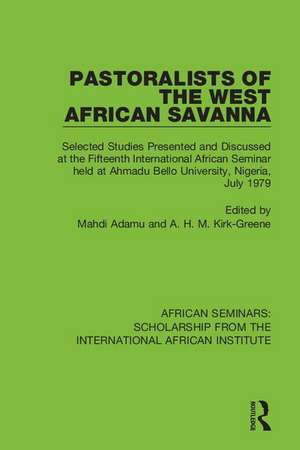Pastoralists of the West African Savanna: Selected Studies Presented and Discussed at the Fifteenth International African Seminar held at Ahmadu Bello University, Nigeria, July 1979: African Seminars: Scholarship from the International African Institute
Editat de Mahdi Adamu, A. H. M. Kirk-Greeneen Limba Engleză Paperback – 24 aug 2020
Toate formatele și edițiile
| Toate formatele și edițiile | Preț | Express |
|---|---|---|
| Paperback (1) | 323.23 lei 6-8 săpt. | |
| Taylor & Francis – 24 aug 2020 | 323.23 lei 6-8 săpt. | |
| Hardback (1) | 891.36 lei 6-8 săpt. | |
| Taylor & Francis – 6 aug 2018 | 891.36 lei 6-8 săpt. |
Din seria African Seminars: Scholarship from the International African Institute
-
 Preț: 258.66 lei
Preț: 258.66 lei -
 Preț: 258.72 lei
Preț: 258.72 lei -
 Preț: 323.23 lei
Preț: 323.23 lei -
 Preț: 317.86 lei
Preț: 317.86 lei -
 Preț: 323.23 lei
Preț: 323.23 lei - 34%
 Preț: 2935.35 lei
Preț: 2935.35 lei -
 Preț: 323.23 lei
Preț: 323.23 lei -
 Preț: 323.23 lei
Preț: 323.23 lei
Preț: 323.23 lei
Nou
Puncte Express: 485
Preț estimativ în valută:
61.85€ • 64.58$ • 51.19£
61.85€ • 64.58$ • 51.19£
Carte tipărită la comandă
Livrare economică 04-18 aprilie
Preluare comenzi: 021 569.72.76
Specificații
ISBN-13: 9781138334526
ISBN-10: 1138334529
Pagini: 396
Dimensiuni: 156 x 234 x 21 mm
Greutate: 0.45 kg
Ediția:1
Editura: Taylor & Francis
Colecția Routledge
Seria African Seminars: Scholarship from the International African Institute
Locul publicării:Oxford, United Kingdom
ISBN-10: 1138334529
Pagini: 396
Dimensiuni: 156 x 234 x 21 mm
Greutate: 0.45 kg
Ediția:1
Editura: Taylor & Francis
Colecția Routledge
Seria African Seminars: Scholarship from the International African Institute
Locul publicării:Oxford, United Kingdom
Public țintă
General, Postgraduate, and UndergraduateCuprins
Part 1: Historical Perspectives
1. Les armées peul de l'Adamawa au 19e siècle 2. Fulani Continuity and Change under Five Flags
3. Maudu Laawol Pulaaku: Survival and Symbiosis
4. The Role of the Fulani and Twareg Pastoralists in the Central Sudan, 1405-1903 5. The Shuwa Arabs6. The Koyam Part 2: Language and Literature
7. Fula Language Studies: Present Position and Future Prospects
8. Aspects de la Littérature Peul
9. Fula Lexicography
10. The Fulani Women Poets Part 3: Nomads and Pastoralists
11. L'expansion des élévers peul dans les savenes humides du Cameroun
12. La brousse est morte
13. The Economic of Productiona nd Exchange in West African Pastoral Societies 14. Peul at aménagements hydro-agricoles dans la vallée du fleuve Sénégal C. Santoir
15. The Fulani of the Jos Plateau Part 4: Social and Economic Aspects
16. Les sociétés et la civilisation des Peul
17. Langue, culture et économique dans le Futa Guinéen 18. Crises et mutations sociales au Futa-Jalon 19. Le delta intérieur du Niger: organisation spatiale 20. Evolution du Peul urbain: Ngaoundéré
21. Peul Majoritaires, Peul Minoritaires
1. Les armées peul de l'Adamawa au 19e siècle 2. Fulani Continuity and Change under Five Flags
3. Maudu Laawol Pulaaku: Survival and Symbiosis
4. The Role of the Fulani and Twareg Pastoralists in the Central Sudan, 1405-1903 5. The Shuwa Arabs6. The Koyam Part 2: Language and Literature
7. Fula Language Studies: Present Position and Future Prospects
8. Aspects de la Littérature Peul
9. Fula Lexicography
10. The Fulani Women Poets Part 3: Nomads and Pastoralists
11. L'expansion des élévers peul dans les savenes humides du Cameroun
12. La brousse est morte
13. The Economic of Productiona nd Exchange in West African Pastoral Societies 14. Peul at aménagements hydro-agricoles dans la vallée du fleuve Sénégal C. Santoir
15. The Fulani of the Jos Plateau Part 4: Social and Economic Aspects
16. Les sociétés et la civilisation des Peul
17. Langue, culture et économique dans le Futa Guinéen 18. Crises et mutations sociales au Futa-Jalon 19. Le delta intérieur du Niger: organisation spatiale 20. Evolution du Peul urbain: Ngaoundéré
21. Peul Majoritaires, Peul Minoritaires
Recenzii
'The International African Institute was at the cutting edge of a fieldwork and ethnographic revolution in African anthropology after 1930. These studies, re-issued by Routledge offer access to these hidden treasures. ' Andrew Bank, University of the Western Cape
Descriere
Originally published in 1986, this volume deals with various aspects of the life of the pastoralists who live in the area between what was Senegambia and Cameroon. It analyses the changing relations between pastoralists and agricultural peoples and the changes that pastoral societies are undergoing with urbanisation.
